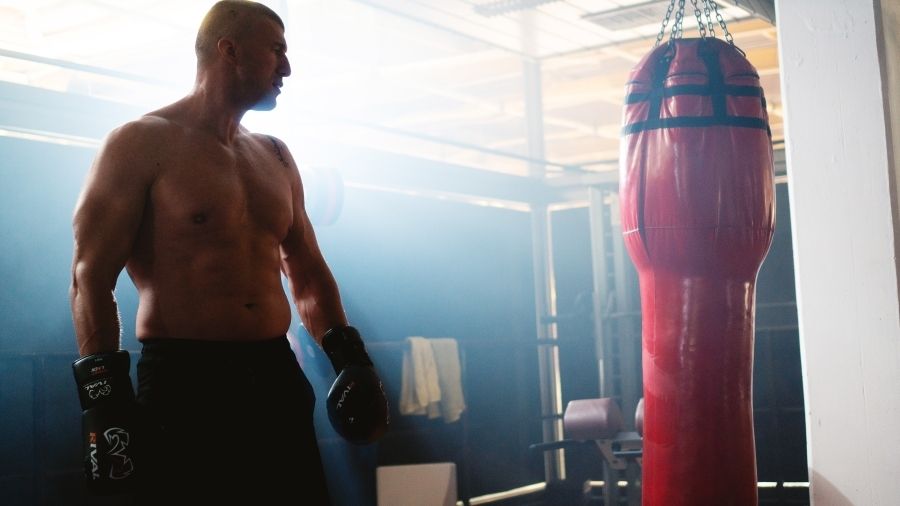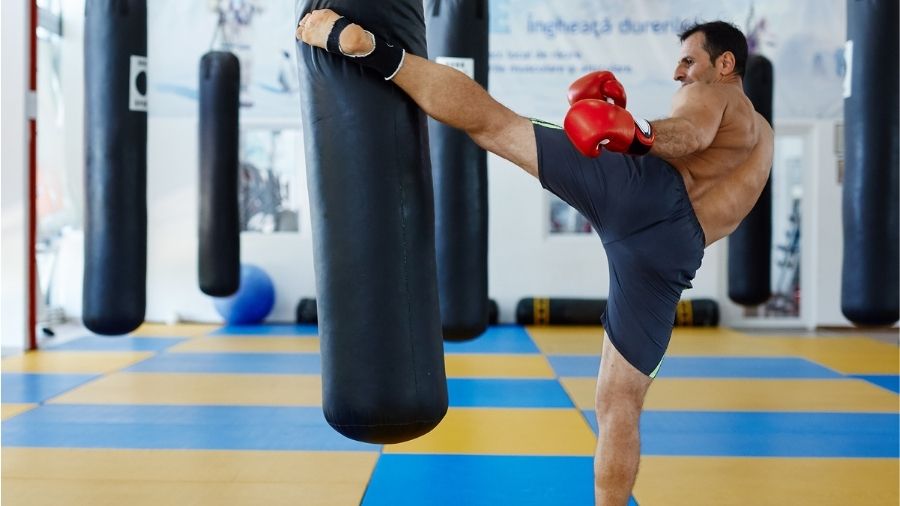When watching professional kickboxers, it’s hard to miss some of the shredded muscular physiques in the ring. It can make you wonder if it is kickboxing that builds muscle or is there something else to it?
Kickboxing does not build muscle as there is little to no resistance when throwing kicks and punches at speed so little force is generated. Building muscle for kickboxing requires lifting weights to maximize mechanical tension and metabolic stress.
If kickboxing doesn’t build muscle, why is that and how can we build muscle as kickboxers without making us slow?
What Muscles Does Kickboxing Work?
Kickboxing is a full-body workout. It works almost every muscle in the body from the calves, hamstrings, quadriceps, glutes, back, core, chest, shoulders, and arms. When throwing kicks and punches, you need to transfer the force produced by pushing into the ground with your feet to either your opposite leg or hands.
Does Kickboxing Build Muscle?

Even though kickboxing is a full-body workout, it does not build muscle. Why? Because it doesn’t satisfy the key mechanisms of hypertrophy (aka muscle growth). These are mechanical tension and metabolic stress [1].
Discover The Little Known Secrets For Unlocking Devastating KO Power!
Heavy hands are built doing these things...
Mechanical is simply maximizing force production through the stretch of the muscle. Meaning lifting heavy weights through a full range of motion. But you can also achieve high levels of mechanical tension when taking lighter loads closer to failure [2].
Kickboxing does nothing to do generate mechanical tension or metabolic stress. This is mainly due to having minimal resistance when throwing punches and kicks and the inverse relationship between force and velocity [3].
Meaning the faster the movement, the less force that can be generated. Less force means less mechanical tension.
Metabolic stress is simply the build-up of by-products that develop in the muscle from energy production [4]. It is associated with the “burn” you feel when grinding out those last few reps of a heavy set in the gym.
Again, kickboxing won’t maximize metabolic stress either. While your shoulders may burn in your first few kickboxing sessions from holding your hands up, you adapt very quickly where you no longer have this sensation even after a 60–90-minute class.
Does Kickboxing Build Glutes?
While the glutes are highly important when kicking for stabilizing your stance leg and generating power, kickboxing won’t grow your glutes. To move your glutes through a large range of motion, you would need to bend at the hips under load.
This would put the glutes under stretch with load and create the mechanical tension needed for muscle growth. Bending at the hips while kickboxing is a sure-fire way to get punched and kicked in the head.
Is Kickboxing Better Than Lifting Weights?

This depends entirely on your training goals. Kickboxing is better for overall cardiovascular health and for learning to fight. Lifting weights is better for developing strength and size. Both activities are completely different and which you decide to do is dependent on what you enjoy.
But guess what? You won’t have to choose one or the other. Lifting weights is an essential aspect of kickboxing preparation. Strength training for kickboxing will help you reduce the risk of injury keeping you healthy to spend more time on the mats. It will also help you to punch harder and what many people may argue against, help you to kick higher.
Does Kickboxing Make You Thicker?
Kickboxing does not make you thicker. To be thick, you need to have a lot of muscle mass and some body fat. Kickboxing is an intense conditioning exercise that doesn’t spur muscle growth and because of the energy expenditure, will make it harder to put on body fat if training hard and often.
If your goal is to get thick while training kickboxing, then make sure to hit the gym! You will likely have to scale back your kickboxing sessions to be able to lift weights 3-4 times a week. If you are not a competitive kickboxer or your goal isn’t to fight anytime soon, then you can do this.
If not, then I would not advise doing this. Further, you will need to eat more calories than you usually would day to day to start putting on weight. A good rule of thumb is to multiply your bodyweight in pounds by 16-17 to get your estimated calorie intake to start gaining weight.
Does Kickboxing Build Leg Muscle?

Kickboxing does not build leg muscle. There’s a reason you see many kickboxers with skinny legs. For one, extra leg mass is not conducive to kickboxing performance. Heavier legs require more oxygen and therefore, can affect your kickboxing conditioning. Secondly, you can’t throw lightning-fast kicks with huge legs.
The physics don’t allow it. Thirdly, the training required to develop huge legs will sap your energy away from kickboxing training which is the most important aspect of your preparation. And finally, this type of training, essentially bodybuilding, is going to make you slower through a whole range of strength training adaptations.
Do Kickboxers Lift Weights?
Kickboxers do lift weights. It has become more common in the modern era as strength and conditioning have permeated their way into the martial arts. Many fighters and coaches realize that when lifting weights is done properly, it only enhances speed and power. It is when it is done poorly that the fighter suffers and strength training is labeled as making fighters slow.
Summary
Kickboxing unfortunately will not build muscle. If you want to become a tank, you’re going to need to pick up some iron. Just be aware, an over-emphasis on lifting weights will be detrimental to your kickboxing performance. However, when lifting weights is planned properly can turn your feet and hands into devastating weapons.
References
1. Schoenfeld, B. J. (2010). The mechanisms of muscle hypertrophy and their application to resistance training. The Journal of Strength & Conditioning Research, 24(10), 2857-2872.
2. Schoenfeld, B. J., Peterson, M. D., Ogborn, D., Contreras, B., & Sonmez, G. T. (2015). Effects of low-vs. high-load resistance training on muscle strength and hypertrophy in well-trained men. The Journal of Strength & Conditioning Research, 29(10), 2954-2963.
3. Gordon, A. R., & Siegman, M. J. (1971). Mechanical properties of smooth muscle. I. Length-tension and force-velocity relations. American Journal of Physiology-Legacy Content, 221(5), 1243-1249.
4. Schoenfeld, B. J. (2013). Potential mechanisms for a role of metabolic stress in hypertrophic adaptations to resistance training. Sports medicine, 43(3), 179-194.

